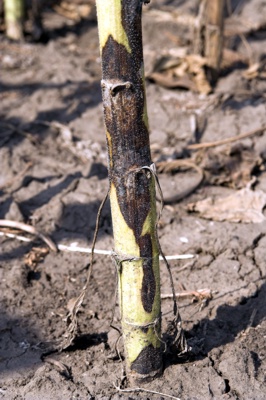Diseases
Leptosphaeria lindquistii Frezzi - Black Stem of Sunflower, Phomosis.
Systematic position.
Kingdom Fungi, phylum Ascomycota, class Ascomycetes, order Pleosporales, family Leptosphaeriaceae, genus LeptosphaeriaSynonyms:
Phoma macdonaldi Boerema; Phoma oleraceae var. helianthi tuberosi Sacc. ( http://www.SpeciesFungorum.org ).Biological group.
Saprotroph.Morphology and biology.
The causative agent of Phomosis or Black Stem of Sunflower forms during its teleomorpha (Leptosphaeria lindquistii) and anamorpha (Phoma macdonaldi) stages of development. Mycelium of the fungus is multicellular, light to dark gray; alpha-spores are formed in spherical pycnidia; perithecia are spherical, slightly extended from above, asci are cylindrical, extended; ascospores are cylindrical, with transverse septae. Pycnidia and perithecia are formed mainly on surface tissues of stalks or under their epidermis. The pathogen affects all parts of plants, but the disease is most clearly shown on the surface of stalks as black oblong or ringed necrosis. Dark necrosis can be seen in a radical part of the stalk. The disease appears in the growth stage on the surface of 3-4 true leaves as dark- brown lesions, limbated with yellow border. Later they pass through the leaf petiole to the stem and head, affecting seeds as a result. At severe affection of stalks, the pathogen penetrates into their stalk core. In this case, maceration of affected tissue occurs. Sources of the infection are the affected residues and infected seeds. Vectors of the infection are the insects carrying pycno-spores from the diseased plants to healthy ones, as well as drops of rain (Maric' et al., 1987).Distribution.
Black Stem of sunflower was registered for the first time in Russia in 1966 (Tikhonov, 1975). Now this disease is shown on sunflowers everywhere within the territories of the former USSR (Yakutkin, 2005).Ecology.
The causative agent L.lindquistii can grow and develop at temperatures ranging from 5 to -31°C. Air temperature 20-25°C and soil humidity about 60% are optimum for mass affection of sunflower by the pathogen (Kukin, 1982).Economic significance.
The affected plants wilt and dry up. Sunflower quality and yield loss caused by the disease may reach 25% (Yakutkin, 2005).Control measures are crop rotation, use of less susceptible varieties and hybrids, and pre-sowing treatment of seeds.Reference citations:
Kukin V.F. 1982. Diseases of sunflower and their control. Moscow: Kolos, 80 p.(in Russian).Maric A., Camprag D. & Masirevic S. 1987. Sunflower diseases and pests and their control. Belgrade: Nolit, 379 p. (in Serbian).
Tikhonov O.I. 1975. Diseases of sunflower. In: Pustovoit V.S., ed. Sunflower. Moscow: Kolos: 391-425 (in Russian).
Yakutkin V.I. 2005. Mapping of sunflower diseases in Russia and CIS countries. In: Pavlyushin V.A., ed. Second All-Russian Congress of Plant Protection. Saint Petersburg, 5-10 December, 2005. Phytosanitary improvement of ecosystems (Materials of Congress in two volumes). Vol. 1. Saint Petersburg: VIZR, p.125-127 (in Russian).


